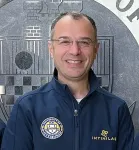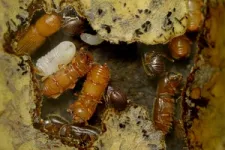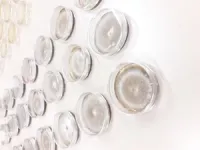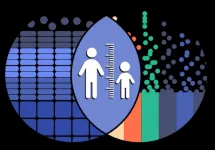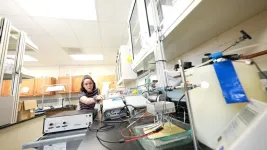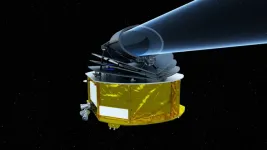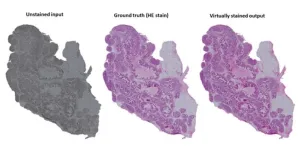(Press-News.org) Young babies and newborn mice can naturally heal damage to the bones that form the top of the skull, but this ability is lost in adults. In a new study published in Proceedings of the National Academy of Sciences, University of Pittsburgh researchers developed a novel approach that promoted bone regeneration in mice without implantation of bone tissue or biomaterials.
The technique uses a device similar to an orthodontic wire used to realign teeth to carefully stretch the skull along its sutures, activating skeletal stem cells that reside in these wiggly seams. In adult mice, the technique repaired damage to the skull that otherwise would not have healed on its own.
“Our approach is inspired by babies because they have an amazing ability to regenerate bone defects in the calvarial bones that make up the top of the skull,” said senior author Giuseppe Intini, D.D.S., Ph.D., associate professor of periodontics and preventive dentistry at the Pitt School of Dental Medicine, member of the McGowan Institute for Regenerative Medicine and an investigator at UPMC Hillman Cancer Center. “By harnessing the body’s own healing capacity with autotherapies, we can stimulate bone to heal itself. We hope to build on this research in the future to develop novel therapies for people.”
Trauma, congenital defects and surgery to treat cancer or other diseases are common causes of damage to the skull. After people reach the age of about 2 years, such injuries don’t heal on their own.
“In babies, the calvarial bones are not completely fused, so the sutures where stem cells reside are still open,” said Intini. “We wondered whether the unfused sutures had something to do with the bone regenerative capacity observed in babies and hypothesized that we could reverse engineer this in adults by mechanically opening the sutures to activate the stem cell niche and boost stem cell numbers.”
In mice — which have very similar skull development to humans — the researchers used a so-called bone distraction device to carefully apply a controlled pulling force to the calvarial bones, strong enough to slightly widen the sutures but not enough to cause a fracture. Using single-cell RNA sequencing and live-imaging microscopy, they found that the number of stem cells in the expanded sutures of these animals quadrupled.
As a result, mice treated with the device regenerated bone to heal a large defect in the skull.
“If you can effectively activate the stem cell niche, you can increase the number of stem cells and sustain regeneration of bone defects,” said Intini. “Remarkably, we showed that the defect can heal even if it’s away from the suture.”
Although the approach was effective in healing skeletally mature 2-month-old mice, the age that roughly translates to young adulthood in humans, it did not work in 10-month-old, or middle-aged, rodents.
“In older mice, the quantity of stem cells in calvarial sutures is very low, so expanding this niche is not as effective in boosting healing capacity,” Intini explained. “Overcoming this challenge is a focus of research to come.”
Current treatments for damage to the skull are usually bone grafts or implantation of biomaterials that act as scaffolds for bone regeneration, but these approaches are not always effective and come with risks, said Intini.
The researchers are investigating how their findings could be used to inform novel therapies in people, not just to heal skull injuries but also fractures in long bones such as the femur. Bone distraction devices are already used to treat certain conditions such as a birth defect called craniosynostosis, in which the calvarial bones fuse too early, so expanding this technique to promote bone regeneration could be a future focus of clinical trials.
Intini and his team are also investigating non-mechanical approaches to activate skeletal stem cells such as medications.
Other authors who contributed to the study were Zahra A. Aldawood, D.M.Sc, of the Harvard School of Dental Medicine and Imam Abdulrahman Bin Faisal University; Luigi Mancinelli, Ph.D., Xuehui Geng, M.D., M.S., Taiana C. Leite, D.D.S., M.S., and Roberta Di Carlo, Ph.D., all of Pitt; Shu-Chi A. Yeh, Ph.D., and Charles P. Lin, Ph.D., both of Massachusetts General Hospital; Jonas Gustafson, of Seattle Children’s Research Institute; Katarzyna Wilk, M.S., Joseph Yozgatian, D.D.S., M.M.Sc., Ph.D., Sasan Garakani, D.D.S., and Seyed Hossein Bassir, D.D.S., D.M.Sc., of the Harvard School of Dental Medicine; and Michael L. Cunningham, M.D., Ph.D., of the Seattle Children’s Research Institute and the University of Washington.
This research was supported by the National Institutes of Health’s National Institute of Dental and Craniofacial Research (grants #R00DE021069 and #R01DE026155).
END
Healing the unhealable: New approach helps bones mend themselves
2023-04-14
ELSE PRESS RELEASES FROM THIS DATE:
Scientists narrow down pool of potential height genes
2023-04-14
When it comes to height, our fate is sealed along with our growth plates—cartilage near the ends of bones that hardens as a child develops. Research publishing April 14 in the journal Cell Genomics shows that cells in these plates determine the length and shape of our bones and can hint at our stature. The study identified potential "height genes" and found that genetic changes affecting cartilage cell maturation may strongly influence adult height.
"The study is really understanding ...
Finding the dream team to beat the heat
2023-04-14
Associate Professor Jonathan Boreyko leads a team at Virginia Tech that has built a strong portfolio of work with ice and water, exploring the possibilities for de-icing planes, building novel water harvesting devices, and creating snow globes out of bubbles. This familiarity with water has given the team a strong sense of its behavior in different states, leading to a new project that shows how ice quenches heat in comparison to water. The findings were published in Chem on April 14.
Mojtaba Edalatpour and master’s student Camryn ...
Analysis of health and prescription data suggests chronic health conditions in U.S. incarcerated people may be severely undertreated
2023-04-14
Chronic conditions such as type 2 diabetes, asthma, HIV infection, and mental illness may be greatly undertreated in the U.S. jail and prison population, suggests a new study from researchers at the Johns Hopkins Bloomberg School of Public Health.
For their analysis, the researchers used national health survey data covering 2018 to 2020 to estimate rates of chronic conditions among recently incarcerated people, and a commercial prescription database to estimate the distribution of medication treatments to the jail and prison population. Their analysis suggests ...
In-person vs virtual education and community COVID-19 case incidence following school re-openings
2023-04-14
About The Study: In a study of matched pairs of counties that reopened with in-person versus virtual instruction at the secondary school level in the 2020 to 2021 academic year, counties with in-person school instructional models early in the COVID-19 pandemic experienced increases in county-level COVID-19 incidence at six and eight weeks after in-person reopening, compared with counties with virtual instructional models.
Authors: Meredith Matone, Dr.P.H., of Children’s Hospital of Philadelphia, is the corresponding author.
To access the embargoed study: Visit our For The ...
Black representation in the primary care physician workforce and its association with population life expectancy
2023-04-14
About The Study: The findings of this study of survival outcomes for 1,618 U.S. counties suggest that greater representation of Black primary care physicians (PCPs) in the PCP workforce is associated with improved survival-related outcomes for Black individuals, although there was a dearth of U.S. counties with at least one Black PCP during each study time point. Investments to build a more representative PCP workforce nationally may be important for improving population health.
Authors: John E. Snyder, M.D., M.S., M.P.H., and Rachel D. Upton, Ph.D., of the U.S. Department of Health and Human Services in Rockville, Maryland, are the corresponding ...
Racial, ethnic differences in barriers faced by medical college admission test examinees
2023-04-14
About The Study: In this study of 81,755 Medical College Admission Test examinees, American Indian or Alaska Native, Black, and Hispanic students reported lower parental educational levels, greater educational and financial barriers, and greater discouragement from pre-health advisers than white students. These barriers may deter groups underrepresented in medicine from applying to and matriculating at medical school.
Authors: Jessica Faiz, M.D., M.S.H.P.M., of the Veterans Affairs Greater Los Angeles Healthcare System and UCLA in Los Angeles, is the corresponding ...
Calling AI experts! Join the hunt for exoplanets
2023-04-14
Artificial Intelligence (AI) experts have been challenged to help a new space mission to investigate Earth’s place in the universe.
The Ariel Data Challenge 2023, which launches on 14 April, is inviting AI and machine learning experts from industry and academia to help astronomers understand planets outside our solar system, known as exoplanets.
Dr Ingo Waldmann, Associate Professor in Astrophysics, UCL (University College London) and Ariel Data Challenge lead said:
“AI has revolutionised many fields of science and industry in the past years. The field of exoplanets has fully arrived in the era of big-data and cutting edge AI is needed to break ...
Estonian researchers developed a method for instant energy-performance label
2023-04-14
The researchers of the FinEst Centre for Smart Cities of Tallinn University of Technology (Estonia, Europe) developed the DigiAudit platform to monitor and analyse energy use and indoor climate indicators of buildings and large real estate portfolios in real time. Thinnect, an Estonian IoT start-up company, will help sell the solution and market it worldwide.
We can only reach zero-emission buildings when we have reliable data
The European Union has set a target for all buildings to be zero-emission, or near-zero energy, by 2050. However, there is no reliable data on the energy consumption of many buildings, so it is not possible to monitor the condition ...
Researchers developed an AI-based method to replace chemical staining of tissue
2023-04-14
Researchers from the University of Eastern Finland, the University of Turku, and Tampere University have developed an artificial intelligence-based method for virtual staining of histopathological tissue samples as a part of the Nordic ABCAP consortium. Chemical staining has been the cornerstone of studying histopathology for more than a century and is widely applied in, for example, cancer diagnostics.
“Chemical staining makes the morphology of the almost transparent, low-contrast tissue sections visible. Without it, analysing tissue morphology is almost impossible for human vision. Chemical staining is irreversible, and in most ...
Rescuing corneal cells from death with the help of mitochondria
2023-04-14
Québec City, April 14, 2023 - Fuchs' endothelial corneal dystrophy, a degenerative eye disease, causes progressive vision loss that can induce blindness. It is the leading cause of corneal transplantation, but the scarcity of grafts hinders its treatment. A research team from Université Laval and Université de Montréal has identified a way to slow the disease and even avoid transplantation if diagnosed at an early stage.
In people with the disease, the endothelial cells at the back of the cornea die more quickly than in healthy people. "Everyone loses them at a slow rate, slow enough to make it to the end of our lives ...
